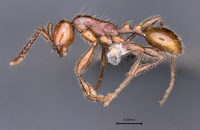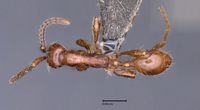Aenictus kodagura
| Aenictus kodagura | |
|---|---|

| |
| Scientific classification | |
| Kingdom: | Animalia |
| Phylum: | Arthropoda |
| Class: | Insecta |
| Order: | Hymenoptera |
| Family: | Formicidae |
| Subfamily: | Dorylinae |
| Genus: | Aenictus |
| Species: | A. kodagura |
| Binomial name | |
| Aenictus kodagura Shakur & Bagchi, 2024 | |
Most known specimens of Aenictus kodagura were hand collected following excavation activities in a coffee plantation, along with Aenictus kadalarensis, Anochetus daedalus, Carebara affinis, Centromyrmex feae and Dorylus orientalis. A single specimen was collected in a pitfall trap from coffee plantations (Coffeea robusta) dominated by silver oak (Grevillea robusta), jackfruit (Artocarpus spp.) and black plum (Syzygium spp.), while additional specimens were collected in a pitfall trap from a forest fragment.
Photo Gallery
Identification
Aenictus kodagura is placed in the A. pachycerus species group due to the following characters:
- anterior clypeal margin being convex and lacking denticles
- lacks a gap between mandibles and anterior clypeal margin when mandibles are closed
- head and first gastral segment smooth
- mesonotum not visibly demarcated from mesopleuron
- indistinct metanotal groove
- pedunculate petiole
- a weakly developed subpetiolar process
Aenictus kodagura shares affinities with Aenictus sirenicus from Borneo, as both have a smooth and shiny head, slender body, smooth pronotum and sculptured propodeum, slender and elongated petiole, and poorly developed parafrontal ridges. However, it can be differentiated by the following characters, among others:
- A. kodagura is a smaller species with a broader head (TL < 2.3 mm, HL < 0.71 mm, CI > 80), but A. sirenicus is a larger species with a narrow head (TL > 3.3 mm, HL > 0.8 mm, CI < 80)
- Presence of an anteriorly directed subpetiolar process in A. kodagura, but A. sirenicus lacks subpetiolar process
- The petiole and postpetiole are almost similar in length in A. kodagura, but the petiole is longer than the postpetiole in A. sirenicus
- Aenictus kodagura is unicolored pale brown, but A. sirenicus is bicolored with mesosoma darker than the rest of the body
Six species of the A. pachycerus group are known from India: Aenictus aitkenii, Aenictus dentatus, Aenictus kadalarensis, Aenictus kodaguensis, Aenictus pachycerus and Aenictus punensis. Aenictus kodagura can be distinguished from A. aitkenii, A. dentatus, A. kodaguensis and A. pachycerus in having a smooth head and pronotum while it is microreticulated in the others. Aenictus kodagura can be distinguished from A. kadalarensis in having a sculptured propodeum and pedunculated petiole instead of smooth propodeum and cuboidal petiole; it can be distinguished from A. punensis in having a subpetiolar process.
Keys including this Species
Distribution
Latitudinal Distribution Pattern
Latitudinal Range: 12.3° to 12.2°.
| North Temperate |
North Subtropical |
Tropical | South Subtropical |
South Temperate |
- Source: Shakur & Bagchi, 2024
Distribution based on Regional Taxon Lists
Oriental Region: India (type locality).
Distribution based on AntMaps
Distribution based on AntWeb specimens
Check data from AntWeb
Countries Occupied
| Number of countries occupied by this species based on AntWiki Regional Taxon Lists. In general, fewer countries occupied indicates a narrower range, while more countries indicates a more widespread species. |

|
Estimated Abundance
| Relative abundance based on number of AntMaps records per species (this species within the purple bar). Fewer records (to the left) indicates a less abundant/encountered species while more records (to the right) indicates more abundant/encountered species. |

|
Biology
Castes
Nomenclature
The following information is derived from Barry Bolton's Online Catalogue of the Ants of the World.
- kodagura. Aenictus kodagura Shakur & Bagchi, 2024: 210, fig. 2 (w.) INDIA (Karnataka).
Type Material
- Holotype: worker from India, Karnataka, Kodagu district, Teralu, Coorg raga, 12.27042°N, 75.75820°E, 905 m alt., hand collection, 11.v.2022, Mohammad Abdus Shakur leg. (IISc)
- Paratypes: 40 workers from India, Karnataka, Kodagu district, Teralu, Coorg raga, 12.27042°N, 75.75820°E, 905 m alt., hand collection, 11.v.2022 (same info as holotype); 1 worker from India, Karnataka, Kodagu district, Arji, 12.18166°N, 75.79683°E, 911 m alt., pitfall trap, 26.i.2021; 1 worker from Bhetri, 12.27026°N, 75.75824°E, 906 m alt., pitfall trap, 23.ii.2021; Mohammad Abdus Shakur leg. (IISc, NCBS)
Description
Measurements (n = 7, holotype measurements are in parenthesis). HL 0.66–0.71 (0.66), HW 0.55–0.59 (0.55), SL 0.51–0.58 (0.54), PnW 0.31–0.34 (0.32), WL 0.98–1.07 (1.05), PL 0.24–0.28 (0.24), PH 0.21–0.23 (0.22), PW 0.14–0.16 (0.14), PPL 0.24–0.27 (0.24), PPH 0.2–0.23 (0.21), PPW 0.14–0.16 (0.14), TL 2.13–2.33 (2.19), CI 80–87.88 (83.33), SI 92.72–101.75 (98.18).
Head: Head in full-face view slightly longer than broad (CI – 83.33) with posterior and lateral margins weakly convex. Eye and typhlatta spots (a pair of large, pale patches located on the posterolateral portion of the head that contrast sharply with the remainder of the head) absent. Antenna 10-segmented, scape long (SI – 98.18), reaching posterior margin of head. Frontal carinae short, not extending beyond the posterior margin of antennal sockets. Parafrontal ridges small and indistinct. Clypeus indistinct; anterior margin of clypeus convex and lacks denticles. When mandibles are closed, no gap exists between mandibles and clypeus. Masticatory margin of mandibles with two teeth (apical and pre-apical) followed by 7–11 denticles of two sizes, the larger alternating with 1–2 smaller. Pre-apical tooth smaller than apical tooth; some individuals have a single denticle on the basal mandibular margin.
Mesosoma: Mesosoma elongate, gradually sloping towards propodeum (in profile view), promesonotal suture and metanotal groove indistinct. In profile, pronotum convex and forms a continuous line with mesonotum. In dorsal view, anterior margin of pronotum nearly straight, anterolateral corners slightly angulated. In profile, propodeum weakly convex, slightly lower than pronotum. In dorsal view, anterior and posterior margins of propodeum roughly equal. Propodeal declivity encircled with a distinct rim. Propodeal spiracle vertically ellipsoid or slit shaped, located close to the dorsal propodeal margin. Mesopleuron continuous with mesonotum. Mesopleuron and metapleuron are separated by a narrow furrow. In some workers, the promesonotum forms a stronger arch and visibly breaks the dorsal outline, while it is continuous in others. Petiole and Postpetiole: Petiole and postpetiole pedunculate to subsessile, and roughly equally long. In profile, petiole longer than high, dorsum of petiole and post-petiole rounded. In dorsal view, petiole and postpetiole longer than broad. Subpetiolar process with a low, sharp anteriorly directed triangular lobe. Postpetiole with a sharp anteroventral edge.
Gaster: Oval. Sting present.
Color: Whole body pale brown. Antennae, mandibles, mesosoma, and tibiae are darker, while the head, coxae, femur, petiole, post-petiole, and gaster are lighter.
Sculpture: Head mostly smooth and shiny, except for a few scattered hair pits. Antennal scapes and funicular segments matt, covered by a fine microreticulum. Mandibles mostly smooth with few scattered hair pits. Dorsum of pronotum smooth without any sculpture; mesonotum and propodeum transversely rugulo-reticulate. Meso-metanotal suture obsolete. In profile, anterior and lateral sides of pronotum faintly microreticulate; mesopleuron, lateral and posterolateral margins of propodeum rugulo-reticulate. Petiole and postpetiole micro-reticulate laterally, dorsum smooth. Legs mostly smooth and shiny, apical portion of femur and tibia superficially reticulate. Gaster smooth and shiny.
Pilosity: Represented predominantly by long setae mixed with few short setae scattered across the body, except lateral sides of the pronotum and mesonotum which lack setae. Longest setae on pronotum on average 0.26 mm long.


